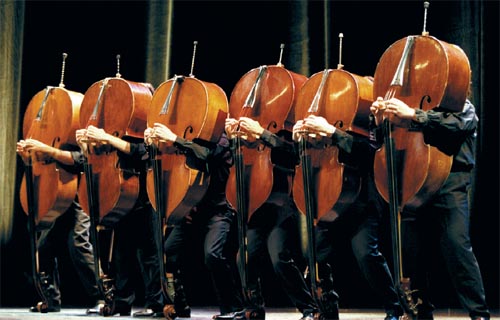Lowly contrabass takes center stage

Held upside down, these contrabasses look like people. L’Orchestre de Contrabasses gives new life to the under-appreciated instrument through spirited performances that put the instrument, and its player, in the spotlight. Provided by L’Orchestre de Contrabasses
All of these sounds, you may be surprised to learn, were made by the contrabass - six of them to be exact. All six instruments, along with their players, appear in a new show by L’Orchestre de Contrabasses, a French company that is returning to Seoul this month for its first performance here in four years.
The contrabass has long played a supporting role in the orchestra because of its large size and low range. There is even a play about the under-appreciated instrument. In “The Double Bass,” by Patrick Suskind, a humble contrabassist describes his frustrations with his instrument, telling the audience how little attention he and his double bass get compared to their colleagues.
L’Orchestre de Contrabasses change all of that with performances that put the contrabass and its player front and center on stage.
The ensemble was created in 1981 by Christian Gentet, a professor at Le Conservatoire National Superieur de Musique et de Danse de Paris, and consists of six contrabassists, all of whom serve as both composers and performers.
For the last 20 years, the ensemble has produced a number of hit songs, most notably one called “Bass, bass, bass, bass, bass & bass.” The song has frequently been played by many other contrabassists since its release in 1993. Other songs such as “Heureuse qui comme Elis” and “Father Moqueur,” which were written by members of the group, are also well known.
L’Orchestre de Contrabasses has performed to critical acclaim not only at its home in France, but also in Germany, Sweden, the United States, Brazil and Japan.
Le Monde wrote that “They have proved themselves to be musical pioneers in France,” while Allgemeine Zeitung said that “These six virtuosi admirably and tactfully multiply the possibilities of their strings, at the crossroads of jazz, the blues and classical music.”
The group has also won over audiences in Korea, where they have been nicknamed the “Dancing Contrabasses.” Their concert in February 2001 was sold out, leading to an encore performance here three months later.
The group has produced a number of CDs, which you can of course listen to, but the experience of seeing them in concert shouldn’t be missed.
The way the musicians commune with their instruments, eliciting strange sounds and human movements, will stay with you long after you leave the theater.
*L’Orchestre de Contrabasses will perform on April 28 at 8 p.m. at the Seoul Arts Center Concert Hall. Go to Nambu Bus Terminal Station, line No. 3, exit 5. Tickets range from 20,000 won ($18) to 110,000 won. For reservations, call 1544-1555 or visit http://ticket.interpark.com. For more information, call (02) 2000-6309 or visit www.sac.or.kr.
By Kim Ho-joung [spark0320@joongang.co.kr]
Related Korean Article
‘춤추는 콘트라바스’ 28일 서울 예술의전당 공연
무대 위 연주자는 단지 여섯 명. 하지만 열두 명이 나온 듯한 착각을 일으킨다. 키 2m에 달하는 악기 때문이다. 꼭 사람 같은 느낌을 준다. 악기를 연인처럼 끌어안은 연주자들이 사뿐히 왈츠 선율에 몸을 맡긴다. ‘파트너’는 보통 오케스트라의 가장 뒷줄에 서 있는, 그래서 ‘병풍 악기’로 불리곤 하는 콘트라바스다.
무대 위 조명이 갑자기 꺼진다. 그러자 콘트라바스가 밀림의 새 소리를 낸다. 원숭이의 울음소리까지 흉내 낸다. 무대 위에 싱그러운 자연을 펼쳐놓는다. 현악기 중 가장 음역의 낮은, 즉 둔한 악기라는 고정관념이 깨지는 순간이다.
심지어, 랩도 한다. 속사포 같은 속도로 랩을 쏟아낸다. 몸놀림이 기민하다. 콘트라바스의 큰 덩치가 믿어지지 않을 정도다. 이게 끝이 아니다. 연기에도 도전한다. 무대에 덩그러니 누워 있는 콘트라바스. 그 악기에 연주자가 천천히 다가가 한 음 한 음 활을 긋는다. 둘 사이에 여느 드라마 이상의 긴장감이 흐른다.
한글 기사 보기
‘춤추는 콘트라바스’ 28일 서울 예술의전당 공연
무대 위 연주자는 단지 여섯 명. 하지만 열두 명이 나온 듯한 착각을 일으킨다. 키 2m에 달하는 악기 때문이다. 꼭 사람 같은 느낌을 준다. 악기를 연인처럼 끌어안은 연주자들이 사뿐히 왈츠 선율에 몸을 맡긴다. ‘파트너’는 보통 오케스트라의 가장 뒷줄에 서 있는, 그래서 ‘병풍 악기’로 불리곤 하는 콘트라바스다.
무대 위 조명이 갑자기 꺼진다. 그러자 콘트라바스가 밀림의 새 소리를 낸다. 원숭이의 울음소리까지 흉내 낸다. 무대 위에 싱그러운 자연을 펼쳐놓는다. 현악기 중 가장 음역의 낮은, 즉 둔한 악기라는 고정관념이 깨지는 순간이다.
심지어, 랩도 한다. 속사포 같은 속도로 랩을 쏟아낸다. 몸놀림이 기민하다. 콘트라바스의 큰 덩치가 믿어지지 않을 정도다. 이게 끝이 아니다. 연기에도 도전한다. 무대에 덩그러니 누워 있는 콘트라바스. 그 악기에 연주자가 천천히 다가가 한 음 한 음 활을 긋는다. 둘 사이에 여느 드라마 이상의 긴장감이 흐른다.










with the Korea JoongAng Daily
To write comments, please log in to one of the accounts.
Standards Board Policy (0/250자)